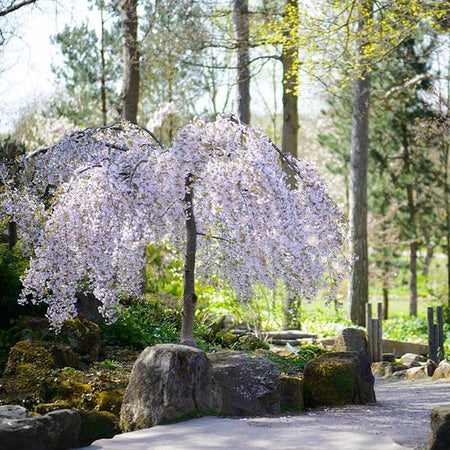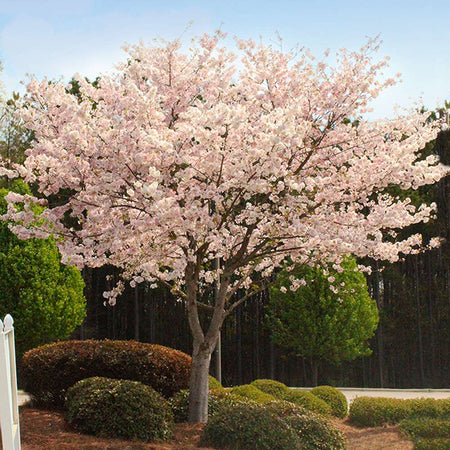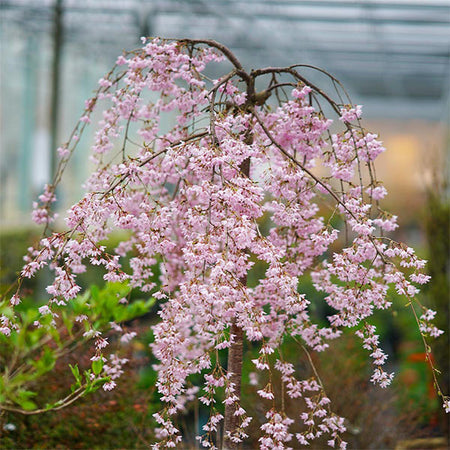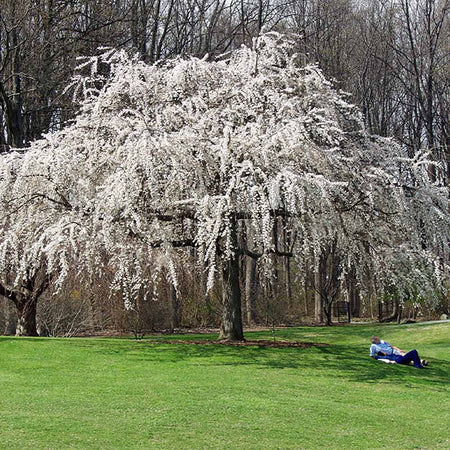Cherry Blossom Trees
Showing 1 - 9 of 9 items
Starting at $137.99
Growing Zones: 5-8
Starting at $133.99
Growing Zones: 5-9
Starting at $133.99
Growing Zones: 5-8
Sold Out
Growing Zones: 4-9
Sold Out
Growing Zones: 4-8
Growing Zones: 4-8
Sold Out
Growing Zones: 5-8
Sold Out
Growing Zones: 5-8
Sold Out
Growing Zones: 6-9
The Complete Guide to Flowering Cherry Trees
Nothing says spring like the bursting of cherry blossoms. When a cherry blossom tree is in full bloom, it serves as the centerpiece of a landscape. And often, the trees are so full, gorgeous and bright that they can be seen from several lawns away. When fall arrives, the foliage adds color again as leaves turn gold or bronze before dropping.
The best part of flowering cherries is that they need less maintenance than fruit-bearing cherries. With full sun and well-draining soil, our cherry blossom trees grow well across many parts of the country and in zones 5 through 8, with just a few exceptions.
The Top Flowering Cherry Tree Varieties
Snow Fountain Weeping Cherry: This is the most popular weeping cherry tree for a reason. The dwarf variety's blooms command much more attention than the care required to produce them.
Okame Cherry Tree: An early bloomer each spring with deep pink blossoms and a mature height of up to 30 feet. The Okame does best in zones 6 through 9.
Kwanzan Cherry Tree: This showy beauty has double pink blossoms in clusters and is hardy to zone 5.
Yoshino Cherry Tree: The Yoshino is the star of popular cherry festivals because of its gorgeous white flowers announcing spring's arrival.
Pink Weeping Cherry: The arching branches of the pink weeping cherry create a pink fountain effect in spring and a glossy green show after the flowers drop.
White Weeping Cherry: The unique shape and bright white blooms of this weeping cherry announce spring with a touch of drama in zones 5 through 8.
Autumn Cherry Tree: A hardier cherry that thrives in zones 4 through 8 and welcomes early spring, or even warm winters, with semi-double blooms.
How and Where To Plant Cherry Trees
Cherry trees should be planted in the spring. Select an area where the tree can get full sun and with plenty of room for the tree's mature size. Some cherry blossom trees can reach heights of up to 40 feet and their canopies can be up to 30 feet wide. Double the impact of the gorgeous blooms and glossy foliage and create summer shade by planting several along a driveway or near your patio. Just be sure to space the plants at least 10 to 20 feet apart.
Most cherry blossom trees grow rapidly, up to 3 feet a year in the first few years. Miniature varieties are available for many types of cherry blossom trees, which adds to their versatility. Weeping trees are the perfect specimen centerpiece of any garden, especially a Japanese or Zen garden.
If your tree arrives as a bare root plant, be sure to follow the directions that come with the tree regarding planting time and steps. The most important step is to plant a bare root tree as quickly as possible, keeping the roots soaking in water until you can place the tree in a hole at least twice as wide as the root system on the tree. You can add a root stimulator to help the roots get started, following directions on the package carefully.
Check the soil requirements for the variety of cherry you've purchased. When planting any cherry tree, be sure to fill the hole carefully and tap the soil gently instead of stepping down on it, which compacts the ground. Cherry trees need well-draining soil. Water heavily and slowly, letting the water drip down to the roots. Add a 3 to 4 inch layer of organic mulch around the tree, being careful to stay several inches away from the trunk. Extend the mulch out to several feet from the trunk to help cool the tree's young roots.
Caring for Cherry Blossom Trees
Most cherry blossom trees do fine in average and varied soils, as long as the soil drains well and the trees receive a medium amount of moisture. Weeping cherries may require more acidic soil than other varieties, and you might need to add some pine mulch or other organic matter to the soil. A young cherry blossom tree needs regular deep watering, at least once a week until established. Cherry trees can handle heat and humidity, but they do not tolerate drought conditions.
Applying a slow-release fertilizer in early spring and early summer can help increase blooms on many varieties of cherry blossom trees. Most cherry blossom trees only need pruning to help train their shape and keep the middle of the tree free of dead branches. You simply need to make sure that air can circulate inside the tree and that its shape appeals to you. Since the trees don't bear fruit, you can't do much harm with light pruning. Once the tree matures, it should need little to no pruning, except removal of dead or damaged branches. You can prune your weeping cherry right after it finishes blooming in spring.
Watch your growing cherry blossom trees for signs of aphids if buds emerge but blooms fail to open. Ants on and under the tree are telltale signs of aphids. The first defense is to spray the tree with a fine mist of water early in the morning to wash aphids away. Ladybugs eat aphids, so if you see them on your tree, be sure to leave them there. Turn to local master gardeners or extension offices for help if you believe your cherry tree might have borers, canker or black rot. The best defense against cherry blossom tree problems is maintaining a healthy tree with regular watering.
Facts About Cherry Blossom Trees
America's love of cherry blossom trees began in the early 1900s, when the Japanese sent thousands of the trees to the nation's capital. Today, the National Cherry Blossom Festival in Washington, D.C., still celebrates the trees' natural beauty. Japan has been breeding ornamental cherry trees for hundreds of years, and the Japanese celebrate the cherry blossom heavily in their culture, even including the blossom as a symbol on the 100-yen coin.
Cherry blossom trees are sterile, which means they do not produce fruit. Instead, growers cultivate the trees to produce more blossoms for their ornamental impact. Cherry blossoms also attract birds and butterflies, which is an added bonus.












